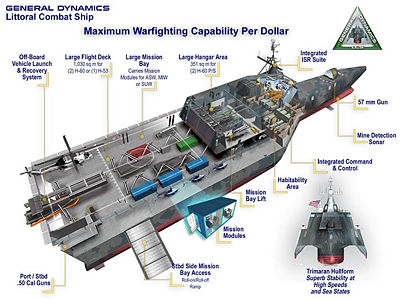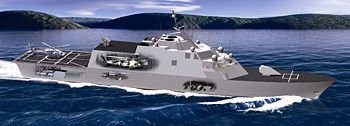Littoral Combat Ship: Difference between revisions
imported>Howard C. Berkowitz No edit summary |
imported>Howard C. Berkowitz |
||
| Line 19: | Line 19: | ||
In all configurations, the vessels have a light 57mm [[autocannon]] that can still provide close-in naval gunfire support as well as engaging surface and air targets. They also carry lighter autocannon and [[RIM-116 Rolling Airframe Missile]]s for self-defense against aircraft and cruise missiles; the ships are also designed to mesh into military electronic networks. | In all configurations, the vessels have a light 57mm [[autocannon]] that can still provide close-in naval gunfire support as well as engaging surface and air targets. They also carry lighter autocannon and [[RIM-116 Rolling Airframe Missile]]s for self-defense against aircraft and cruise missiles; the ships are also designed to mesh into military electronic networks. | ||
===Surface warfare=== | ===Surface warfare=== | ||
For missions where the 57mm does not provide sufficient range, the [[XM501 NLOS launch system]] with [[Precision Attack Missile]]s (PAM), developed as part of the Army's cancelled [[Future Combat Systems]], has been discussed as the base for anti-surface warfare. Military news sources, however, suggest the cheaper [[Griffin]] missile is being considered. In its present form, the Griffin is shorter-ranged than the PAM. It was intended as a replacement for the [[AGM- | For missions where the 57mm does not provide sufficient range, the [[XM501 NLOS launch system]] with [[Precision Attack Missile]]s (PAM), developed as part of the Army's cancelled [[Future Combat Systems]], has been discussed as the base for anti-surface warfare. Military news sources, however, suggest the cheaper [[Raytheon Griffin|Griffin]] missile is being considered. In its present form, the Griffin is shorter-ranged than the PAM. It was intended as a replacement for the [[AGM-114 Hellfire]] launched from [[unmanned aerial vehicle]]s, and reuses components from the [[FGM-148 Javelin]] anti-tank and [[AIM-9 Sidewinder|AIM-9X]] air-to-air missiles, and is in competition for the [[Joint Air-Ground Missile]] procurement. [[Raytheon]] makes both systems. <ref>{{citation | ||
| title = Navy Close to Choosing Griffin Missile for LCS | | title = Navy Close to Choosing Griffin Missile for LCS | ||
| author = John Reed | date = 11 January 2011 | | author = John Reed | date = 11 January 2011 | ||
| url = http://www.dodbuzz.com/2011/01/11/navy-close-to-choosing-griffin-missile-for-lcs/}}</ref> | | url = http://www.dodbuzz.com/2011/01/11/navy-close-to-choosing-griffin-missile-for-lcs/}}</ref> | ||
===Mine warfare=== | ===Mine warfare=== | ||
Revision as of 15:37, 19 February 2011
A Littoral Combat Ship is a United States Navy warship intended to reverse the Cold War trend towards large, expensive warships optimized for open-ocean operations. As opposed to fast attack craft, it is capable of transoceanic voyages to reach its operational area, but, once there, is optimized for littoral warfare in coastal waters. In comparison to LCS, which are ships of approximately 3,000 ton displacement with a crew of 40, the extremely competent, multirole Burke-class destroyers are in excess of 9,000 tons with a crew of 300-400 sailors.
There are two prototype classes being built by different design teams, but they share the ability to be quickly (1-4 days) reconfigured for with mission modules for mine warfare (MIW), anti-submarine warfare (ASW) and anti-surface warfare (ASuW). While small, they will always have the capability to operate helicopters and unmanned aerial vehicles (UAV).
While bringing new capabilities, they are also seen as replacements for the 30 FFG-7 Oliver Hazard Perry-class frigates, 14 Avenger-class mine countermeasures vessels, and 12 MHC-51 Osprey-class coastal mine hunters).[1]
It is described as a "relatively" inexpensive ship, but the first two are in the USD $500 million range. U.S. Marine Corps analysts observe that for each two LCS, one Landing Platform Dock (LPD) of the San Antonio-class could be acquired. An LCS can carry 25 passengers, which could be appropriate for United States Navy SEAL operations, but the Marines have not been involved with the development and it does not support their Force Reconnaissance doctrine.
The Joint High Speed Vessel is similar in being a high-speed ship designed for the littoral, but otherwise quite different; the JHSV is a transport built to commercial standards while the LCS is a warship with naval damage resistance. In littoral operations, however, LCS would be a plausible escort for the JHSV.
Mission equipment
Separately from the modules, there is a launching and retrieval ramp on the stern, as well as a side hatch; this will allow all configurations to launch special operations boats and remotely piloted vessels. Internally, there is a three-axis crane over the area near the side hatches, for efficient movement of equipment inside the modular storage area. There are hangars for two MH-60 helicopters, but the landing area is sufficient for the large CH-53 Sea Stallion heavy-lift or MH-53 PAVE LOW special operations helicopter, but possibly not the V-22 Osprey. They also are using the MQ-8 helicopter UAV, three of which will fit in the hangar space of one MH-60.
In all configurations, the vessels have a light 57mm autocannon that can still provide close-in naval gunfire support as well as engaging surface and air targets. They also carry lighter autocannon and RIM-116 Rolling Airframe Missiles for self-defense against aircraft and cruise missiles; the ships are also designed to mesh into military electronic networks.
Surface warfare
For missions where the 57mm does not provide sufficient range, the XM501 NLOS launch system with Precision Attack Missiles (PAM), developed as part of the Army's cancelled Future Combat Systems, has been discussed as the base for anti-surface warfare. Military news sources, however, suggest the cheaper Griffin missile is being considered. In its present form, the Griffin is shorter-ranged than the PAM. It was intended as a replacement for the AGM-114 Hellfire launched from unmanned aerial vehicles, and reuses components from the FGM-148 Javelin anti-tank and AIM-9X air-to-air missiles, and is in competition for the Joint Air-Ground Missile procurement. Raytheon makes both systems. [2]
Mine warfare
Features include the AN/WLD-1 Remote Minehunting UUV System; AN/AQS-20A towed mine-detecting sonar and sensors; the Organic Airborne Surface Influence Sweep (OASIS); the Airborne Laser Mine Detection System (AES-1 ALMDS); the Airborne Mine Neutralization System (AMNS); and the Rapid Airborne Mine Clearance System (RAMICS) 30mm cannon with its “supercavitating” ammunition
Anti-submarine warfare
With the cancellation of several projects, the entire ASW module is under redesign. It may share some sensors with the mine warfare module.
Designs
Both contractors were to build prototypes. Lockheed Martin is building two ships, USS Freedom and USS Courage. The other two, by General Dynamics, are the USS Independence and USS Liberty. While the performance of the two is intended to be in the same range, the hull forms are quite different. Lockheed Martin's is a single hull that "semi-planes", or moves partially out of the water at high speed. The General Dynamics approach is a multi-hulled trimaran.
Deployment
LCS 1 was commissioned in November 2008, following LCS 2's commissioning in October. These are Flight 0 vessels. In January 2007, the USN stopped work on LCS 3 due to cost concerns, and terminated the contract in April. LCS 4 was also cancelled in October 2007. New production will be of Flight 1.
Secretary of Defense Robert Gates, in presenting the proposed Defense Department budget on April 6, 2009, said "We will increase the buy of Littoral Combat Ships (LCS) – a key capability for presence, stability, and counterinsurgency operations in coastal regions – from two to three ships in FY 2010. Our goal is to eventually acquire 55 of these ships."
To increase availability, each ship will have two crews, "Blue" and "Gold", which will take turns manning the vessel at sea. This approach has been used successfully with submarines.
References
- ↑ "The USA’s New Littoral Combat Ships (LCS)", Defense Industry Daily, 19 January 2011
- ↑ John Reed (11 January 2011), Navy Close to Choosing Griffin Missile for LCS

